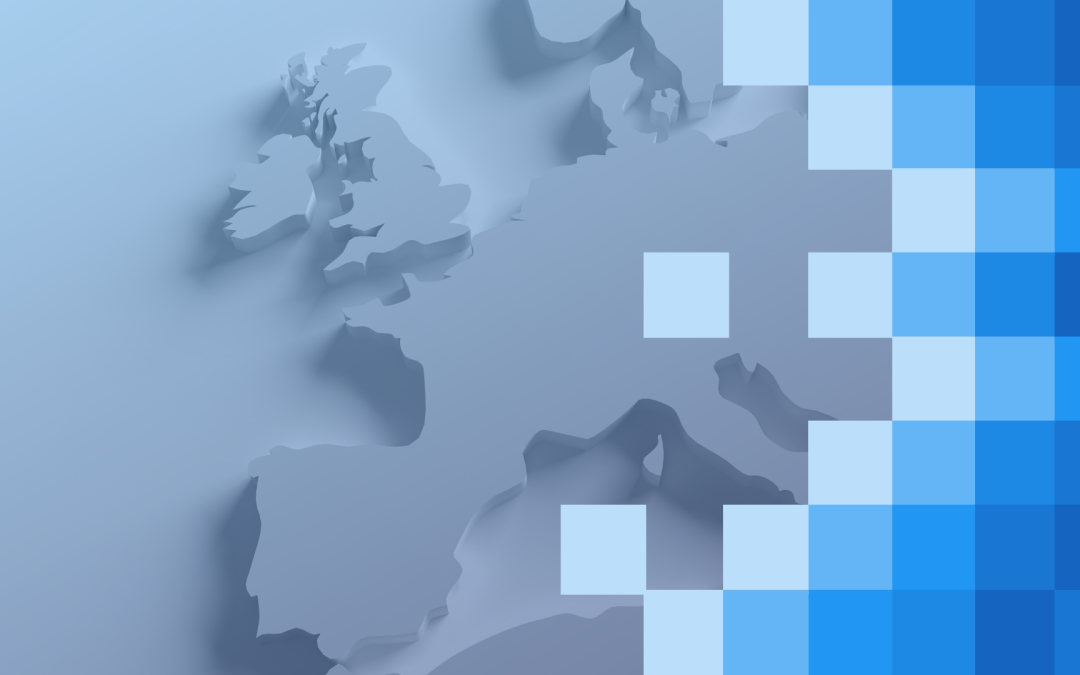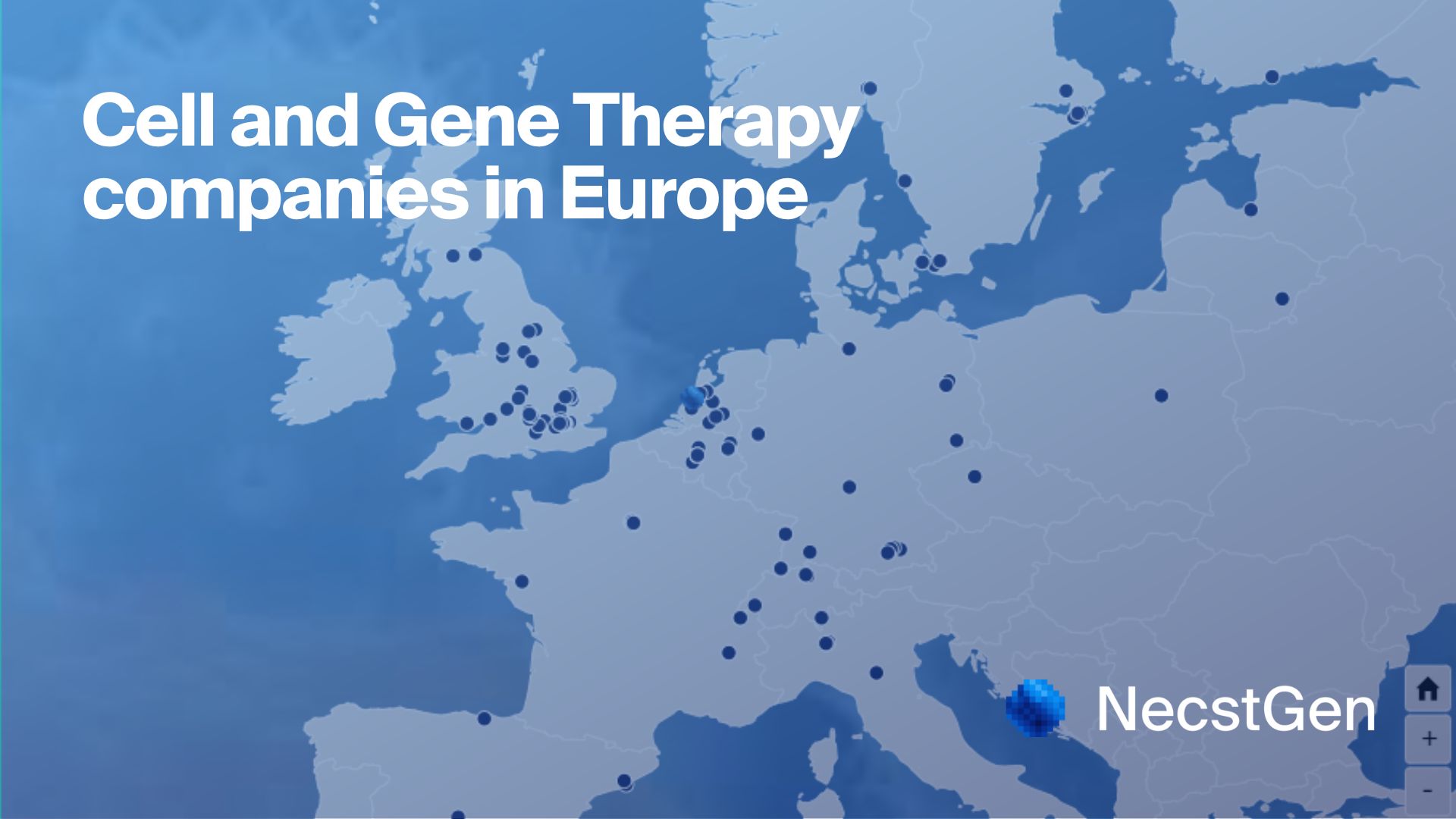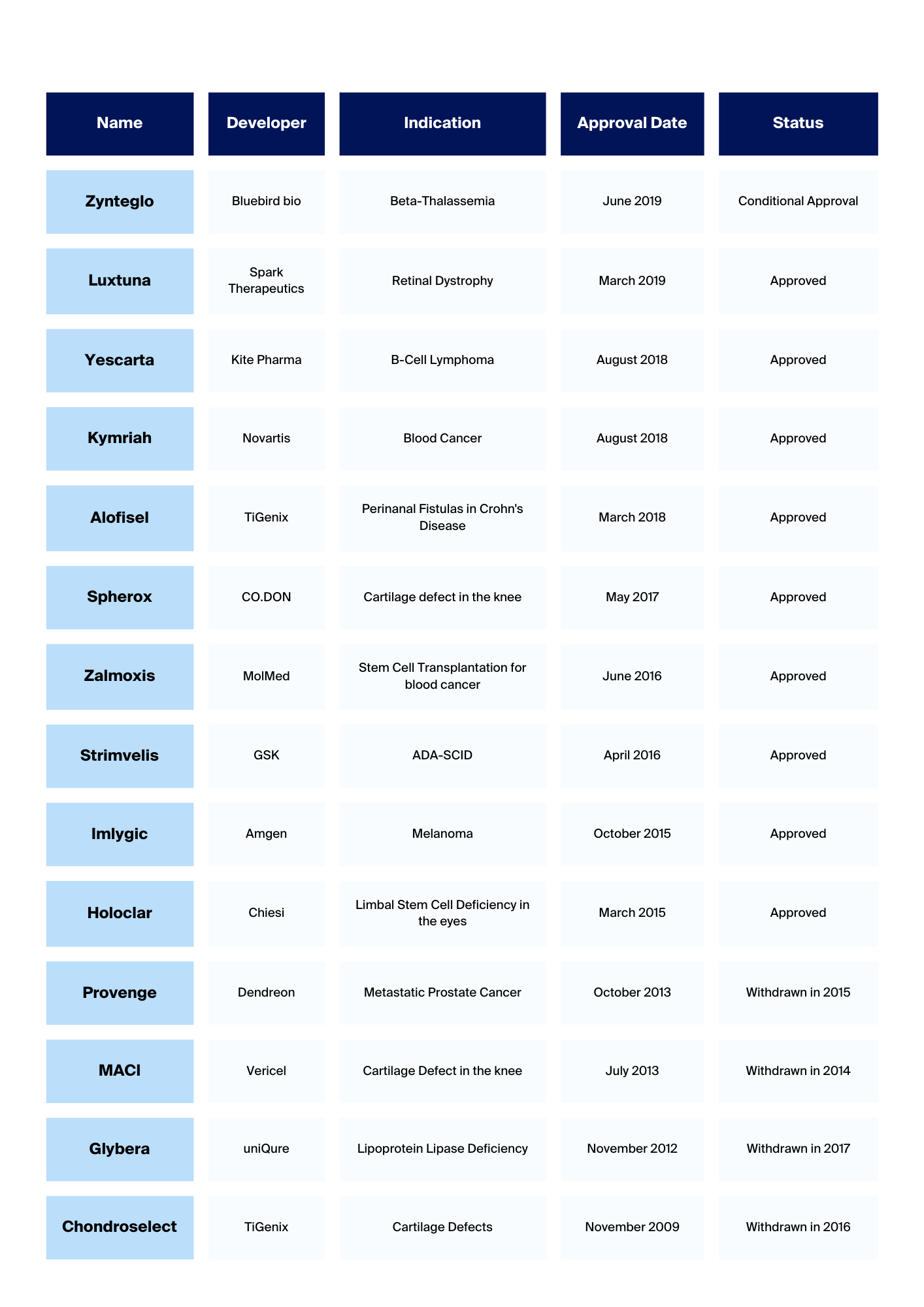
Cell and Gene Therapy companies in Europe
European Cell & Gene Therapy Companies
European Landscape For Cell & Gene Therapy companies
At NecstGen, we aim to support industry partnerships and growth. And to enable the next generation of therapies, it is pivotal to have oversight of the gene and therapy landscape to start from, which is why we created this helpful tool. Feel free to use and share it, so together, we challenge today’s possibilities and enable the unthinkable.
Did we miss your organisation?
The biotechnology business is booming around the globe. Increased private equity investments in biotech, global cross continent acquisition deals, and IPOs have risen to record levels. This boom in development will enable the global biotech industry to surpass its older sibling, the pharmaceutical industry, in interest. One area of biotech that holds a particularly great promise to meet patients’ unmet needs is Cell and Gene Therapy. Such therapies defined as ATMPs (Advanced Therapy Medicinal Products) have a substantial therapeutic potential to treat the patients that current treatments may fail. Although their development can be complex, this is not holding back drug developers, innovation continues in leaps and bounds. But where are most Cell and Gene Therapy developers located? This article and map share insights into the ATMP landscape in Europe and the existence of several hubs
Cell & Gene Therapy Companies in the United Kingdom
With three hotspots in the UK, the Britons lead as Europe’s biotech hub for breakthrough life-science start-ups. McKinsey wrote a fascinating report covering how this hub has matured relative to its peers and what lies ahead on its road to playing a leading role in the Cell and Gene Therapy sector globally.
The report based its results on a Biotech Innovation Index, which assessed the biotech sector on discovery, translation, growth capital, and various impact indicators. Although they do not directly target ATMPs in the study, the large hubs you can see on the map here definitely confirm their findings.
In the UK, most Cell and Gene Therapy companies are located in one of these three clusters:
Cell & Gene Therapy Companies in the Netherlands
The Netherlands has several biotech hubs, all connected through a strong infrastructure network despite its size. Its central location in Europe makes it no surprise that EMA relocated its headquarters to Amsterdam following Brexit in 2020. The Netherlands is also home to several knowledge centres with extensive capacity in Cell and Gene Therapies
Investments into the Leiden University Medical Center (LUMC) have accelerated patient access to innovative Cell & Gene Therapies, including stem-cell therapies. NecstGen is a fruit of those investments and supports organisations worldwide to develop novel therapies for patients. In addition, Utrecht is home to the Utrecht Cell Therapy Facility: a hub for ATMP development specialised in Cell and Tissue based therapies.
In the Netherland, most Cell and Gene Therapy companies are located in these clusters:
Switzerland
Switzerland is known for being the home country of pharmaceutical giants Roche and Novartis and many other leading biotech companies. Together, the combined sector contributes over 40% of Swiss exports. Over 300 biotech start-ups are located in the country and specialise in diverse fields such as oncology, antibodies, and orthopaedics. It’s not a surprise that multiple Swiss companies have already worked on advancing their presence in Cell & Gene Therapy.
Novartis opened its Cell and Gene Therapy facility back in 2019, for manufacturing Kymriah. Last month, Cytiva opened its new manufacturing facility in Grens (Link) and served as the base of operations regarding their Cell and Gene Therapy-related operations and a training centre for European customers.
Swiss Biotech companies are located around the following three clusters:
Italy
The Italian biotechnological sector is concentrated around the northern parts of the country. The North-Western part of Italy is where companies specialising in drug development and new therapeutic approaches appear to be located, including for Cell & Gene Therapies.
Italy’s ATMP-specific service provider market ranks third in Europe. Therefore, it may not also surprise that some of the earliest advanced therapies and four out of seventeen authorised for the European market originate from Italian academic research. Nature published an article on the challenging yet promising future of ATMP development in Italy.
In Italy, most biotech companies specialised in Cell and Gene Therapy are located in Milan and surroundings.
Germany
Even though there is no clear hotspot in which Cell and Gene Therapy-focussed companies are settled in Germany, the sector has seen immense growth. This builds on the underlying strength of Germany in R&D and manufacturing in Pharma. The country is home to 660 biotech companies with a total of 50,000 employees. Of those 660 companies, many are focused on Cell & Gene Therapy.
In 2021, more than 29 active clinical trials evaluating CAR-modified immune cells took place, most of which involved CAR-T cells. In Germany, over 50 clinical studies have been conducted in Gene Therapy, making Germany a country heavily involved in the development of Cell & Gene Therapies. Nature published an interesting report on the past and future of Gene Therapy in Germany.
The German Cell and Gene Therapy companies are not clustered, but are located all throughout the country, demonstrating the broad strength of innovation locally.
France
Named as one of the best three biotech centres in Europe by McKinsey, France is home to 720 biotech companies with a combined workforce of over 50,000 employees.France has a thriving academic environment, which can be seen from the number of biotech firms backed by academic research, which was forty-six percent iin 2017.
It may come as no surprise that France is one of the leading countries in Cell and Gene Therapy research. The French government and biotech companies invested in Gene Therapy development early on, and it paid off. More than 10-world leading biotech companies and research groups operate from France, such as Genethon. While most companies and institutes involved in Cell and Gene Therapy development, such as Institut Imagine or Institut Vision are located in Paris and its surroundings, there are several other biotech hubs in France.
Sweden
Sweden definitely has the ambition to rank globally as a Cell and Gene Therapies player. They share the aspiration of the countries mentioned above to provide patients with innovative treatments and have even started a program specifically tailored to ATMPs, Vinnova. By following this programme, Sweden aims to be a leader in advanced therapies by 2030!
The complete program involves partners, including research companies, universities, the Swedish Medical Products Agency, patient representatives, and the pharmaceutical industry’s trade association. Therefore, we can consider their combined perspectives and goals the driving force behind the accelerated, developing landscape ATMPs.
We can find a hotspot of ATMP companies located around the Ideon Science Park in Lund
Belgium
Finally, we mention Belgium on our list of hotspots for Cell and Gene Therapy developers. The Belgium biotech industry is thriving, with more than 140 operating biotechs despite its small size. Known for its vivid biotech landscape, Belgium is also developing their share in ATMP development.
Compared to surrounding countries, large companies always favoured Belgium as a country for their manufacturing operations. Shortly, UCB plans to open up a new gene therapy facility in Braine-l’Alleud, and we can expect it to be operational in 2024.
Related Questions
Which Cell Therapies are approved?
In these figures, we gathered and visualised overviews of approved ATMPs over the past years for you.

What does the Cell Therapy Development process look like?
From idea to treatment, you’ll face changing requirement and development challenges. View the figure to see how knowledge of the process inversely relates to freedom to make changes to your process.

Our experts are only a message away to help you understand the impact of any of these aspects and make informed decisions on outsourcing.
We’d be happy to discuss and help you bring cell therapies to patients.





